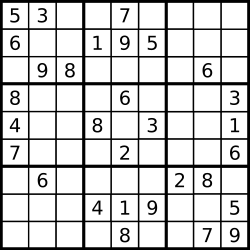[LeetCode] 37. Sudoku Solver
grandyang opened this issue · 1 comments
请点击下方图片观看讲解视频
Click below image to watch YouTube Video
Write a program to solve a Sudoku puzzle by filling the empty cells.
A sudoku solution must satisfy all of the following rules :
- Each of the digits
1-9must occur exactly once in each row. - Each of the digits
1-9must occur exactly once in each column. - Each of the digits
1-9must occur exactly once in each of the 93x3sub-boxes of the grid.
The '.' character indicates empty cells.
Example 1:
**Input:** board = [["5","3",".",".","7",".",".",".","."],["6",".",".","1","9","5",".",".","."],[".","9","8",".",".",".",".","6","."],["8",".",".",".","6",".",".",".","3"],["4",".",".","8",".","3",".",".","1"],["7",".",".",".","2",".",".",".","6"],[".","6",".",".",".",".","2","8","."],[".",".",".","4","1","9",".",".","5"],[".",".",".",".","8",".",".","7","9"]]
**Output:** [["5","3","4","6","7","8","9","1","2"],["6","7","2","1","9","5","3","4","8"],["1","9","8","3","4","2","5","6","7"],["8","5","9","7","6","1","4","2","3"],["4","2","6","8","5","3","7","9","1"],["7","1","3","9","2","4","8","5","6"],["9","6","1","5","3","7","2","8","4"],["2","8","7","4","1","9","6","3","5"],["3","4","5","2","8","6","1","7","9"]]
**Explanation:** The input board is shown above and the only valid solution is shown below:
Constraints:
board.length == 9board[i].length == 9board[i][j]is a digit or'.'.- It is guaranteed that the input board has only one solution.
这道求解数独的题是在之前那道 Valid Sudoku 的基础上的延伸,之前那道题让我们验证给定的数组是否为数独数组,这道让求解数独数组,跟此题类似的有 Permutations,Combinations, N-Queens 等等,其中尤其是跟 N-Queens 的解题思路及其相似,对于每个需要填数字的格子带入1到9,每代入一个数字都判定其是否合法,如果合法就继续下一次递归,结束时把数字设回 '.',判断新加入的数字是否合法时,只需要判定当前数字是否合法,不需要判定这个数组是否为数独数组,因为之前加进的数字都是合法的,这样可以使程序更加高效一些,整体思路是这样的,但是实现起来可以有不同的形式。
一种实现形式是递归带上横纵坐标,由于是一行一行的填数字,且是从0行开始的,所以当i到达9的时候,说明所有的数字都成功的填入了,直接返回 ture。当j大于等于9时,当前行填完了,需要换到下一行继续填,则继续调用递归函数,横坐标带入 i+1。否则看若当前数字不为点,说明当前位置不需要填数字,则对右边的位置调用递归。若当前位置需要填数字,则应该尝试填入1到9内的所有数字,让c从1遍历到9,每当试着填入一个数字,都需要检验是否有冲突,使用另一个子函数 isValid 来检验是否合法,假如不合法,则跳过当前数字。若合法,则将当前位置赋值为这个数字,并对右边位置调用递归,若递归函数返回 true,则说明可以成功填充,直接返回 true。不行的话,需要重置状态,将当前位置恢复为点。若所有数字都尝试了,还是不行,则最终返回 false。检测当前数组是否合法的原理跟之前那道 Valid Sudoku 非常的相似,但更简单一些,因为这里只需要检测新加入的这个数字是否会跟其他位置引起冲突,分别检测新加入数字的行列和所在的小区间内是否有重复的数字即可,参见代码如下:
解法一:
class Solution {
public:
void solveSudoku(vector<vector<char>>& board) {
helper(board, 0, 0);
}
bool helper(vector<vector<char>>& board, int i, int j) {
if (i == 9) return true;
if (j >= 9) return helper(board, i + 1, 0);
if (board[i][j] != '.') return helper(board, i, j + 1);
for (char c = '1'; c <= '9'; ++c) {
if (!isValid(board, i , j, c)) continue;
board[i][j] = c;
if (helper(board, i, j + 1)) return true;
board[i][j] = '.';
}
return false;
}
bool isValid(vector<vector<char>>& board, int i, int j, char val) {
for (int x = 0; x < 9; ++x) {
if (board[x][j] == val) return false;
}
for (int y = 0; y < 9; ++y) {
if (board[i][y] == val) return false;
}
int row = i - i % 3, col = j - j % 3;
for (int x = 0; x < 3; ++x) {
for (int y = 0; y < 3; ++y) {
if (board[x + row][y + col] == val) return false;
}
}
return true;
}
};
还有另一种递归的写法,这里就不带横纵坐标参数进去,由于递归需要有 boolean 型的返回值,所以不能使用原函数。因为没有横纵坐标,所以每次遍历都需要从开头0的位置开始,这样无形中就有了大量的重复检测,导致这种解法虽然写法简洁一些,但击败率是没有上面的解法高的。这里的检测数组冲突的子函数写法也比上面简洁不少,只用了一个 for 循环,用来同时检测行列和小区间是否有冲突,注意正确的坐标转换即可,参见代码如下:
解法二:
class Solution {
public:
void solveSudoku(vector<vector<char>>& board) {
helper(board);
}
bool helper(vector<vector<char>>& board) {
for (int i = 0; i < 9; ++i) {
for (int j = 0; j < 9; ++j) {
if (board[i][j] != '.') continue;
for (char c = '1'; c <= '9'; ++c) {
if (!isValid(board, i, j, c)) continue;
board[i][j] = c;
if (helper(board)) return true;
board[i][j] = '.';
}
return false;
}
}
return true;
}
bool isValid(vector<vector<char>>& board, int i, int j, char val) {
for (int k = 0; k < 9; ++k) {
if (board[k][j] != '.' && board[k][j] == val) return false;
if (board[i][k] != '.' && board[i][k] == val) return false;
int row = i / 3 * 3 + k / 3, col = j / 3 * 3 + k % 3;
if (board[row][col] != '.' && board[row][col] == val) return false;
}
return true;
}
};
Github 同步地址:
类似题目:
参考资料:
https://leetcode.com/problems/sudoku-solver/
https://leetcode.com/problems/sudoku-solver/discuss/15853/Simple-and-Clean-Solution-C%2B%2B
LeetCode All in One 题目讲解汇总(持续更新中...)
(欢迎加入博主的知识星球,博主将及时答疑解惑,并分享刷题经验与总结,快快加入吧~)
微信打赏
Venmo 打赏
推荐一下高票写法, 效率确实很高,如果想写的简单一些最少也应该把所有不确定的位置的可能放的数的数目多少排列一下, 这样可以减小搜索空间
class Solution {
struct Cell{
int value_=0;
int n_allowed_=9;
bitset<10> disallowed_values_;
};
private:
array, 9> cells_;
vector> positions_;
public:
bool set(int row, int col, int value) {
Cell& c = cells_[row][col];
if(c.value_ == value) return true;
if(c.disallowed_values_[value]) return false;
c.disallowed_values_=bitset<10>(0x3FE);
c.disallowed_values_.reset(value);
c.value_= value;
c.n_allowed_=1;
for(int k =0; k<9; ++k){
//along row
if(k!=col && !updateConstraint(row, k, value)) return false;
if(k!=row && !updateConstraint(k, col, value)) return false;
int r = row/3*3+k/3, c = col/3*3+k%3;
if(row != r && col != c && !updateConstraint(r, c, value)) return false;
}
return true;
}
bool updateConstraint(int row, int col, int invalid_value){
Cell& c=cells_[row][col];
if(c.disallowed_values_[invalid_value]) return true;
if(c.value_ == invalid_value) return false;
c.disallowed_values_.set(invalid_value);
--c.n_allowed_;
if(c.n_allowed_==1){
for(int v = 1; v<=9;++v)
if(!c.disallowed_values_[v])
return set(row, col, v);
}
return true;
}
void find_empty_cells(){
positions_.clear();
for(int row = 0; row<9; ++row){
for(int col = 0; col<9; ++col){
Cell& c=cells_[row][col];
if(c.value_==0){
positions_.emplace_back(row, col);
}
}
}
auto lambda_cmp=[this] (const pair& p1, const pair& p2) {return cells_[p1.first][p1.second].n_allowed_ < cells_[p2.first][p2.second].n_allowed_;};
sort(positions_.begin(), positions_.end(), lambda_cmp);
}
bool backtrace(int k){
if(k == positions_.size()) return true;
int row = positions_[k].first, col = positions_[k].second;
Cell& c=cells_[row][col];
if(c.value_) return backtrace(k+1);
array, 9> snapshot(cells_);
for(int v =1; v<=9; ++v){
if(c.disallowed_values_[v]) continue;
if(set(row, col, v))
if(backtrace(k+1)) return true;
cells_=snapshot;
}
return false;
}
public:
void solveSudoku(vector>& board) {
for(int row = 0; row<9; ++row){
for(int col = 0; col<9; ++col){
if(board[row][col] !='.' && !set(row, col, board[row][col]-'0')) return;
}
}
find_empty_cells();
if(backtrace(0)){
for(int row =0; row<9; ++row){
for(int col = 0; col<9; ++col){
if(cells_[row][col].value_)
board[row][col] = '0'+cells_[row][col].value_;
}
}
}
}
};





